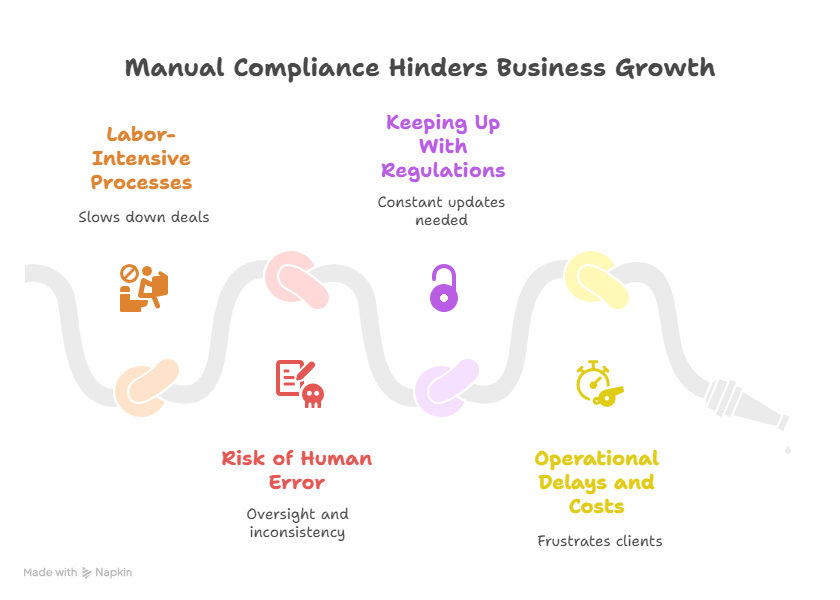The real estate sector has long been a target for money laundering with high-value transactions and less oversight than banks. As regulations tighten, property professionals face expanding Anti-Money Laundering (AML) obligations. This article examines key AML requirements under European Union (EU) law, common money laundering risks in real estate, the challenges of manual compliance, and how automation can help firms reduce their exposure.
AML Compliance Obligations in Real Estate
Under EU law, real estate businesses are considered “obliged entities” subject to AML rules alongside banks. This means real estate professionals involved in property deals must conduct thorough customer due diligence on buyers and sellers. They must verify each client’s identity and determine the ultimate beneficial owner (UBO) for corporate buyers, ensuring the true buyer is known. Clients are also screened against sanctions and politically exposed person (PEP) watchlists to flag any high-risk parties for closer review.
In addition, EU regulations mandate ongoing monitoring of the business relationship and reporting of suspicious transactions to the Financial Intelligence Unit (FIU). Real estate firms must report any suspected money laundering to authorities. Regulations also impose strict record-keeping, so firms must document all checks and retain records for years. To curb illicit cash, the EU caps large cash payments (often around €10,000 for property deals). Deals involving high-risk countries or PEPs require enhanced due diligence. Failing to meet these obligations can lead to severe penalties and reputational damage.
Common AML Risks in Real Estate
Criminals exploit real estate through various money laundering techniques, including:
- Shell and front companies: Criminals often purchase property via shell companies or complex corporate structures to hide the true owner’s identity. Layers of entities and nominee buyers make it difficult to trace the real source of funds.
- Large cash transactions: High-value property deals done in cash let criminals inject illicit funds without leaving an obvious audit trail. By avoiding banks, they bypass financial reporting systems, making detection harder.
- Opaque ownership structures: Trusts and third-party nominees are used to conceal the real owner. Such arrangements hide the ultimate beneficial owner and complicate due diligence.
- Price manipulation and collusion: Property values can be deliberately over- or under-valued to facilitate laundering. With collusion from complicit insiders, criminals can inflate or deflate prices to disguise illicit money flows.

Challenges of Manual AML Compliance
For many real estate firms, meeting AML requirements manually is a resource-intensive and error-prone endeavor. Key challenges include:
- Labor-intensive processes: Performing due diligence for each client means collecting and verifying numerous documents (IDs, proof of funds, etc.) and cross-checking databases. Doing all of this by hand for every transaction is time-consuming and can slow down deals.
- Risk of human error: Manual processes are prone to oversight and inconsistency. A busy agent might miss a red flag or overlook that a client is on a sanctions list. Such slips can result in compliance violations, regulatory fines, or reputational harm.
- Keeping up with regulations: AML rules and watchlists change frequently. Without automation, compliance teams must constantly update their knowledge and procedures. Smaller agencies may especially struggle to adjust processes for each new law or directive.
- Operational delays and costs: Lengthy KYC checks frustrate clients and may even drive them away. Staff hours spent on repetitive checks also raise costs. In short, heavy reliance on manual compliance can hinder business growth while still leaving potential gaps in risk coverage.

How Automation Helps Reduce AML Risk
Automation can significantly strengthen AML compliance in the real estate sector by addressing many of the above challenges. By leveraging specialized software and data tools, companies can streamline their anti-money laundering efforts. Key benefits of automating AML include:
- Automated risk assessment: Smart AML platforms automatically risk-rate clients and transactions using predefined criteria. Factors such as a client’s location, profile, and transaction size are analyzed to assign a risk score, flagging high-risk cases for closer review. This ensures attention goes to the areas of highest risk, and the system can continuously monitor for any new suspicious indicators.
- Digital identity verification: Automation accelerates identity checks by using digital KYC solutions. These tools can scan and authenticate IDs or passports, use biometric verification to confirm the individual, and cross-check clients instantly against sanctions and PEP databases. This not only speeds up onboarding but also reduces the chance of overlooking a high-risk or blacklisted individual.
- UBO discovery and verification: Modern AML solutions quickly pinpoint ultimate beneficial owners by integrating with global corporate registries. Instead of staff manually untangling complex company ownership, the software reveals who ultimately controls a corporate buyer (for example, any person with over 25% ownership). This makes it much harder for criminals to hide behind layers of companies.
- Streamlined documentation and reporting: An automated system maintains a complete digital audit trail of all compliance steps. Every ID check, risk score, and ownership verification is logged and stored, making it easy to demonstrate compliance during audits. If a suspicious transaction needs to be reported, the system can help compile the necessary data for regulators, making filings faster and more accurate.
Automated AML Solution for Real Estate
AMLTrack is software designed for obliged entities such as real estate agencies and property firms. The system automates key AML tasks – from verifying client identities and screening them against sanctions lists and PEP databases, to retrieving data from official registers (KRS – National Court Register, CEIDG – Central Register and Information on Economic Activity, CRBR – Central Register of Beneficial Owners), performing risk assessments, and reporting suspicious transactions. All actions are documented and stored in a secure archive, ready for regulatory inspection. This allows real estate professionals to meet legal requirements more quickly and reliably, reducing the risk of human error and costly compliance breaches.
Conclusion
Money laundering threats in real estate continue to evolve, but so do the tools to counter them. By embracing automation, property professionals can stay ahead of criminals and meet their AML obligations with greater ease. Ultimately, automated compliance helps firms reduce risk exposure, protect their reputation, avoid hefty fines, and contribute to a more transparent and secure real estate market.
Why is real estate considered high-risk for money laundering?
The real estate sector is attractive to money launderers because it allows large sums of money to be moved discreetly and converted into stable, long-term assets. Properties—especially in luxury or commercial segments—can be bought with illicit funds and later sold to generate “clean” money. Criminals often use complex structures such as shell companies, nominee buyers, or third parties to mask their identity. Additionally, property valuations can be manipulated to conceal illegal profits. Compared to the banking sector, real estate historically had weaker oversight, making it a soft target for illicit financial activity.
Do small real estate agencies also need to comply with AML regulations?
Yes. Under EU law, all real estate professionals involved in property transactions are considered “obliged entities.” This includes large commercial developers, small agencies, and even independent brokers who help clients buy or sell real estate. The law does not differentiate based on company size. All entities must conduct customer due diligence, report suspicious activity, and maintain proper compliance documentation. Smaller firms, while often with limited resources, are still subject to the same regulatory scrutiny and risk of penalties for non-compliance. That’s why many turn to automation to streamline their obligations without adding headcount.
What is UBO verification and why does it matter in real estate?
UBO stands for Ultimate Beneficial Owner — the person who ultimately owns or controls a legal entity. In real estate, it’s crucial to identify the UBO when a property is purchased through a company, trust, or intermediary. Criminals often use multi-layered company structures across jurisdictions to hide the real buyer and the source of funds. By verifying the UBO, real estate firms help prevent anonymous property purchases used to launder money. EU regulations require firms to conduct UBO checks and to apply enhanced due diligence if the ownership structure appears unusually complex or obscured.
What are the penalties for non-compliance with AML in real estate?
Penalties for AML non-compliance in the real estate sector can be severe. Financial penalties vary by country, but they often reach into the hundreds of thousands or even millions of euros. In some cases, firms may face operational sanctions such as suspension of licenses or exclusion from public contracts. Individuals—such as managing directors or compliance officers—can also be held personally liable if AML failures are found to be due to negligence. Beyond regulatory action, firms risk reputational damage, loss of clients, and negative media coverage. A single lapse in due diligence can have long-term consequences for the business.
Can AML automation help with cross-border real estate deals?
Yes, AML automation is particularly useful for cross-border transactions, which carry higher risks due to differing legal standards, unfamiliar jurisdictions, and language barriers. Automated platforms can instantly access international databases, perform multilingual identity verification, and screen parties against global sanctions and PEP lists. They can also streamline the collection and validation of documents from foreign clients. This ensures consistency and accuracy while reducing delays, which are common in manual processes. For international property firms and clients, automation provides both operational efficiency and a much stronger compliance posture.






